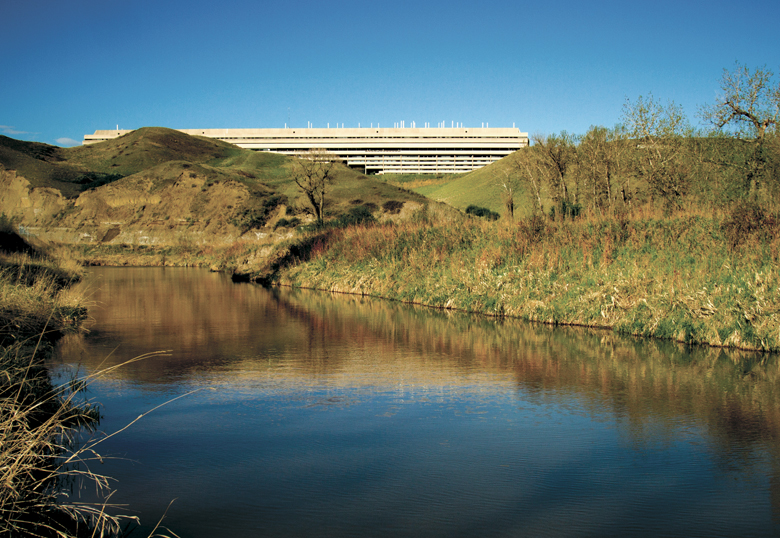Standing knee-deep in a crisp, clear mountain stream, casting a fly as a rainbow trout flashes by, it’s hard to imagine the province’s water supply in jeopardy. We take for granted that when we turn the tap for a glass of water, it will be there, that when we flip the switch for our sprinkler, water will flow.
Alberta is fortunate – its rivers are fed by rain and blessed with mountain snowmelt and water that cascades down to the drier regions of the prairie and parkland zones. It is there where the majority of Albertans live and work, consuming water that has been dammed, stored and diverted off-stream for agricultural irrigation, municipal and domestic use, and to support industrial practices, including vital industries such as oil and gas production.
None of this exists without water, and researchers like Dr. Stewart Rood from the University of Lethbridge’s Water Institute for Sustainable Environments (WISE) are developing strategies to keep our water flowing in a responsible and sustainable manner.

Rood and his team of researchers, many of whom are undergraduate and graduate students at the U of L, are in the midst of a critical study – titled Functional Flows – of the province’s water sources as they come under increased demand from growing human populations and industrial expansion.
“It’s critical for the environmental health of our aquatic ecosystems that we understand the ecological impacts from river damming and water diversions,” says Rood, who is a U of L Board of Governors Research Chair in Environmental Science and a professor in the Department of Biological Sciences. “We need to create and implement strategies for environmental flow regimes that will ensure that our rivers continue to sustain high water quality, as well as the fish and floodplain forests that we value.”
As the human population grows and industrial expansion continues, the demand for Alberta’s surface water progressively increases. This raises fundamental questions: how much water must be left in our rivers to ensure healthy environments; and how can we manage our limited water resources to provide economic prosperity without sacrificing healthy natural environments?
“The focus of this project is to define the instream flow needs, or environmental flows, for Alberta’s rivers and further to develop strategies to deliver these environmental flow regimes, and thus prevent further overuse of our most critical of resources, water,” says U of L Vice-President (Research) Dr. Dan Weeks.
The research projects associated with Functional Flows bring together biologists, geographers and other natural and social scientists affiliated with WISE, working in collaboration with other academic and government researchers. The collaborations also engage regional agencies such as Alberta Environment, the Alberta Conservation Association and the public Watershed Planning and Advisory Councils.
In addition, the research activities also involve a substantial student-training component. Combining classroom work with practical field experience that supports vital research in an area of great need for Albertans is a win-win scenario for the project. It’s also a key reason why ConocoPhillips Canada (CPC) supported the project with an initial $250,000 contribution.
A leading global exploration and production company, CPC looks to support not only the economic vitality of the province, but add to the development of the next generation of environmental researchers. CPC has been a strong supporter of the U of L for more than 15 years through extensive participation in the co-operative education program as an employer. As well, since 2008, CPC has funded 126 U of L scholarships that have recognized the academic achievements of management, arts and science, and Aboriginal students. The company has also provided financial support for students gaining work experience through international placements or in the non-profit sector.
“We see this as an opportunity to engage the research expertise at the University of Lethbridge in a manner that will benefit everyone from students and faculty members involved in the research, to industry, agriculture, municipalities, Aboriginal communities and end users of Alberta’s water resources,” says Lloyd Visser, VP, Environment and Sustainable Development, CPC.
The Government of Alberta also sees Functional Flows as a critical study that could eventually shape how the province manages its water sources, adding a $1 million funding boost to the project through Alberta Innovates – Energy and Environment Solutions (AIEES).

The Functional Flows project was one of 18 provincial projects selected for the Water Resource Sustainability Program that will support the Government of Alberta’s Water for Life strategy.
“With a growing population and expanding economy, it is critical that Alberta has accurate, reliable and useful information and a suite of practical approaches for managing our water resources,” says Eddy Isaacs, CEO of AIEES. “These projects will provide the crucial information we need to support an actionable strategy for safe, secure and sustainable water for Albertans.”
For Rood and his research team, they are already starting to see exciting results from the project. In 2011, a convergence of favourable conditions allowed for the deliberate implementation of Functional Flows for the three dammed rivers of the Oldman Basin, and the Oldman, Waterton and St. Mary rivers. The prior summer had been wet and consequently crop fields had abundant soil moisture. Winter snows were heavy, creating deep snowpacks and spring rains provided more water.
Following the approval of the major irrigation districts that hold the oldest and largest water licenses, Rood and his team worked with Alberta Environment to prescribe and implement flows regimes intended to benefit trout and whitefish and enable the reproduction of cottonwoods and willows.
“The 2011 implementation was very successful as the late spring flow pattern allowed for the seedling establishment of millions of new cottonwoods and willows and there were abundant flows through the warm weeks of summer to benefit the fish,” explains Rood. “There was also abundant water for irrigation and other human uses, and thus no reduction in the economic objectives.”
By connecting industry and leading water researchers, Functional Flows takes important steps to maintain Alberta’s growth and prosperity while ensuring our most valuable resource continues to flow.
